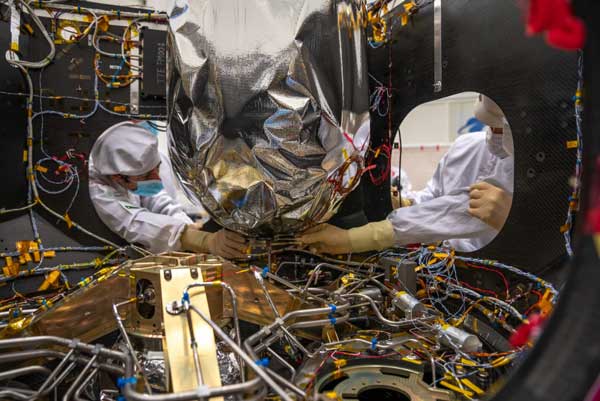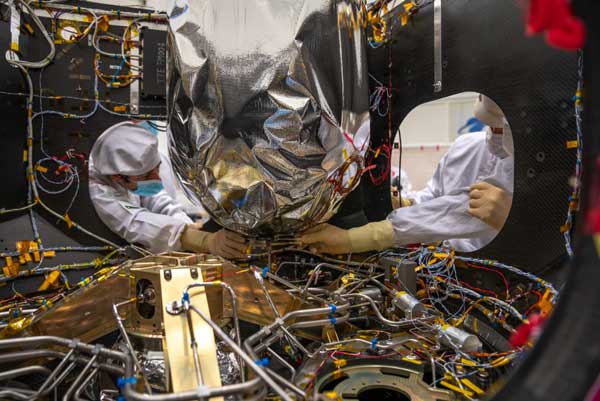
Key Updates for HAKUTO-R Announced as Mission 1 Lander Prepares to Enter Final Stage of Integration (Image Credit: SNN)
M1 and M2 currently planned for launch as early as Q4 2022* and 2024*, respectively, and an early look at a new micro rover planned for first deployment on M2, among other updates
TOKYO – January 25, 2022 – Today, ispace, inc. (ispace), a lunar exploration company with its headquarters in Japan and regional offices in the United States and Europe, shared key developments related to the company’s HAKUTO-R program, which consists of its planned first and second lunar missions, Mission 1 (M1) and Mission 2 (M2).
Key Progress Updates for HAKUTO-R M1 & M2:
● The company’s lunar lander being developed for M1 is on track to enter its final stage of assembly and integration during February 2022*. The current plan is to complete assembly and integration of customer payloads by Spring*, and then begin final testing before shipping the lander to the United States for launch.
● The target launch timing for M1 is currently planned for Q4 2022*, at the earliest, based on the current development schedule.
● The launch for M2 is currently planned to occur within 2024. This time frame has been updated from 2023 to 2024 to reflect internal and external conditions.
● The company provided an early look at the preliminary design of a newly planned micro rover that ispace intends to deploy for the first time on M2.
Since June 2021, members of ispace’s Quality Control & Assembly, Integration & Testing (AIT) team have been stationed at an ArianeGroup GmbH (AGG) facility in Lampoldshausen, Germany, working in collaboration with AGG staff on the final assembly of the lander flight model for M1. As stated above, the lander is nearing the final stage of assembly and integration. Activities to occur in the months ahead include the mating of the main upper and lower assemblies, the installation of components such as radiators, multi-layer insulation (MLI), solar panels, landing gear, and the rover deployment mechanism, as well as customer payloads. Today, ispace released a video produced in December from inside of the AGG facility showed the installation of two of the lander’s four propellant tanks.
The company also provided initial details about the development of a micro rover currently planned to be delivered as a payload to the lunar surface by ispace’s lander during M2*. The company is continuously iterating its rover design to achieve a small-size and low-mass rover. In the future, ispace envisions deploying multiple micro rovers to explore and collect data on the lunar surface. The micro rover, which is based on the foundation of ispace’s previous rover models, is being developed by ispace Europe (ispace EU), the European subsidiary of ispace, with co-funding from the Luxembourg Space Agency through a European Space Agency contract in the Luxembourg National Space Programme, LuxIMPULSE. (Note: ispace EU employs over 20 staff and will celebrate its 5th anniversary this year.)
Key Progress Updates for HAKUTO-R Corporate Partners & Supporting Companies:
■ NGK Spark Plug’s solid-state battery test module has already been integrated into the M1 lander for final testing.
■ Citizen Watch Co., Ltd. (Citizen) installed GPS receivers for the time displays positioned above the monitors inside the HAKUTO-R Mission Control Center, which will be used during M1 & M2 mission operations.
■ HILLTOP Technology Laboratory, Inc. joined the HAKUTO-R program as a Supporting Company. The company has supported M1 through the machining of metal parts for the lander flight model and earlier testing models.
■ Fujikin Inc. joined the HAKUTO-R program as a Supporting Company. The company aspires to apply its experience in the field of space development and hydrogen fuel technologies toward the HAKUTO-R program.
Comment from ispace Founder & CEO, Takeshi Hakamada: “The year ahead is the most important yet for us. This is everything we’ve worked for. Every member of our team has contributed to our progress, and I continue to be grateful for our employees each day. There is still a lot of work to do, so we must remain focused and steadfast as we progress toward our first mission. However, by this time next year, I am optimistic that we will be able to look up at the Moon during the New Year celebrations and see it in a way we’ve never seen before.”
These updates coincided with a planned simulation of the M1 launch operations conducted by ispace’s Operations Team at the HAKUTO-R Mission Control Center (MCC) in Tokyo. The objective of this training is for ispace engineers to prepare for all possible issues that may occur during the mission. The Operations Team at ispace is made up of engineers with experience in space mission operations for the likes of NASA, the Japan Aerospace Exploration Agency (JAXA), the European Space Agency (ESA), and other space agencies.
Mission 1 Payload Manifest
1. The “Rashid” lunar rover from the Dubai-based Mohammed bin Rashid Space Centre (MBRSC)
2. A “transformable lunar robot” from the Japan Aerospace Exploration Agency (JAXA)
3. A test module for a solid-state battery from NGK Spark Plug Co., Ltd. (NGK Spark Plug)
5. Multiple 360-degree cameras from Canadensys Aerospace (Canadensys)
6. A panel engraved with the names of HAKUTO crowdfunding supporters (during Google Lunar XPRIZE)
7. And a payload for which the disclosure of further information can be expected at a future date.
ispace, inc. (https://ispace-inc.com/)
ispace is a lunar exploration company with over 160 staff and offices in Japan, Europe and the United States. ispace builds small commercial lunar landers, aiming to provide a high-frequency, low-cost delivery service to the Moon. Aspiring to be a gateway for private sector companies to bring their businesses to the Moon, ispace has also launched a lunar data business concept to support companies with their entry into the lunar market. The company’s first lunar mission is currently planned for 2022*. The lander for that mission is currently undergoing final assembly at an ArianeGroup facility in Germany and will launch from the United States on a SpaceX Falcon 9 rocket.
HAKUTO-R (https://ispace-inc.com/hakuto-r/)
HAKUTO-R is a commercial lunar exploration program operated consisting of ispace’s first two lunar missions: Mission 1, a soft lunar landing planned to launch in 2022*, and Mission 2, a lunar landing and deployment of a rover planned for 2024*. HAKUTO-R’s Corporate Partners include Japan Airlines Co., Ltd., Mitsui Sumitomo Insurance Co., Ltd., NGK Spark Plug Co., Ltd., Citizen Watch Co., Ltd., Suzuki Corporation, Sumitomo Corporation, Takasago Thermal Engineering Co., Ltd., and Sumitomo Mitsui Banking Corporation and SMBC Nikko Securities Co., Ltd. HAKUTO-R Media Partners include TBS Holdings, Inc., Asahi Shimbun Co., Ltd., and Shogakukan Co., Ltd.









